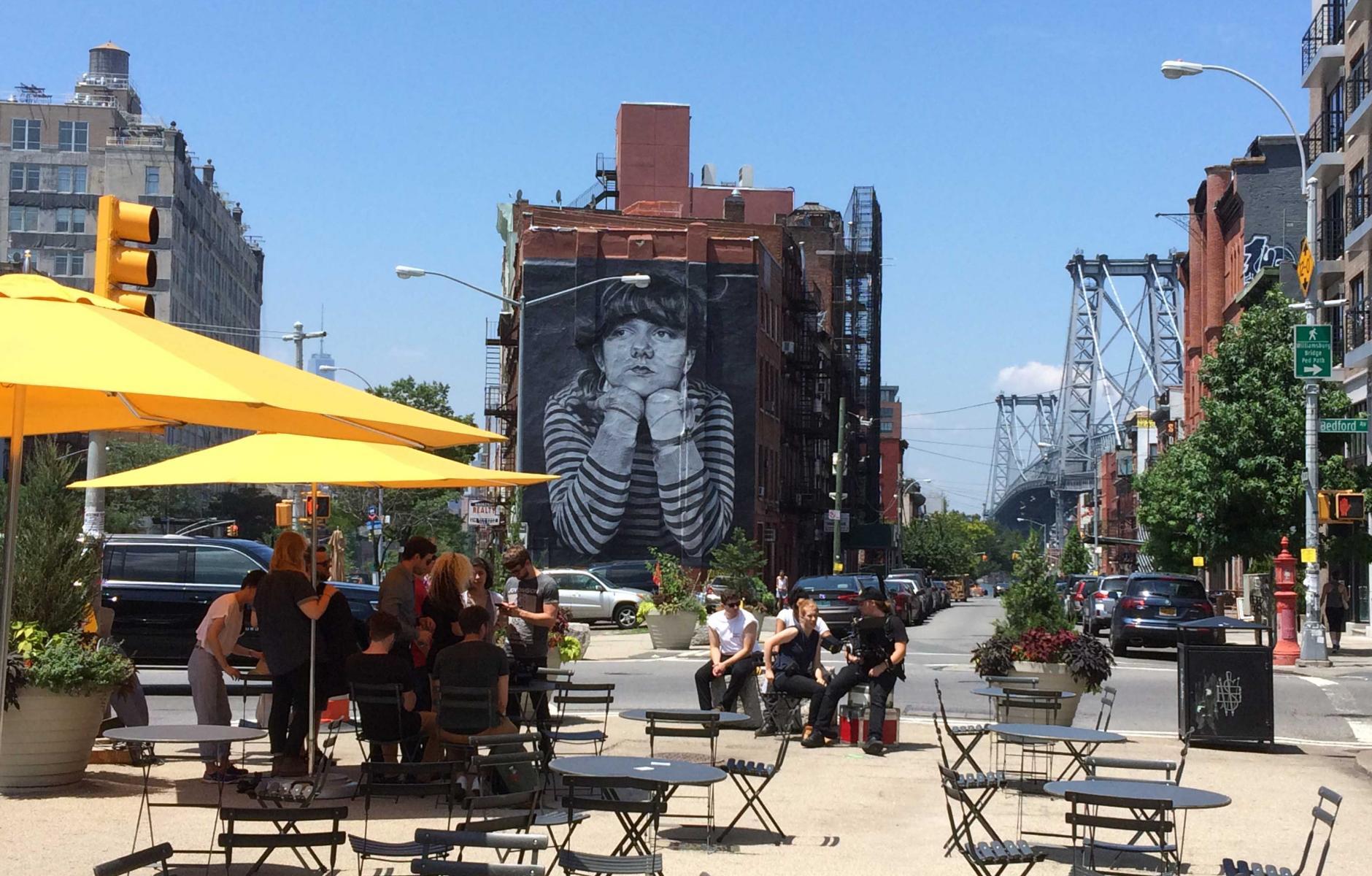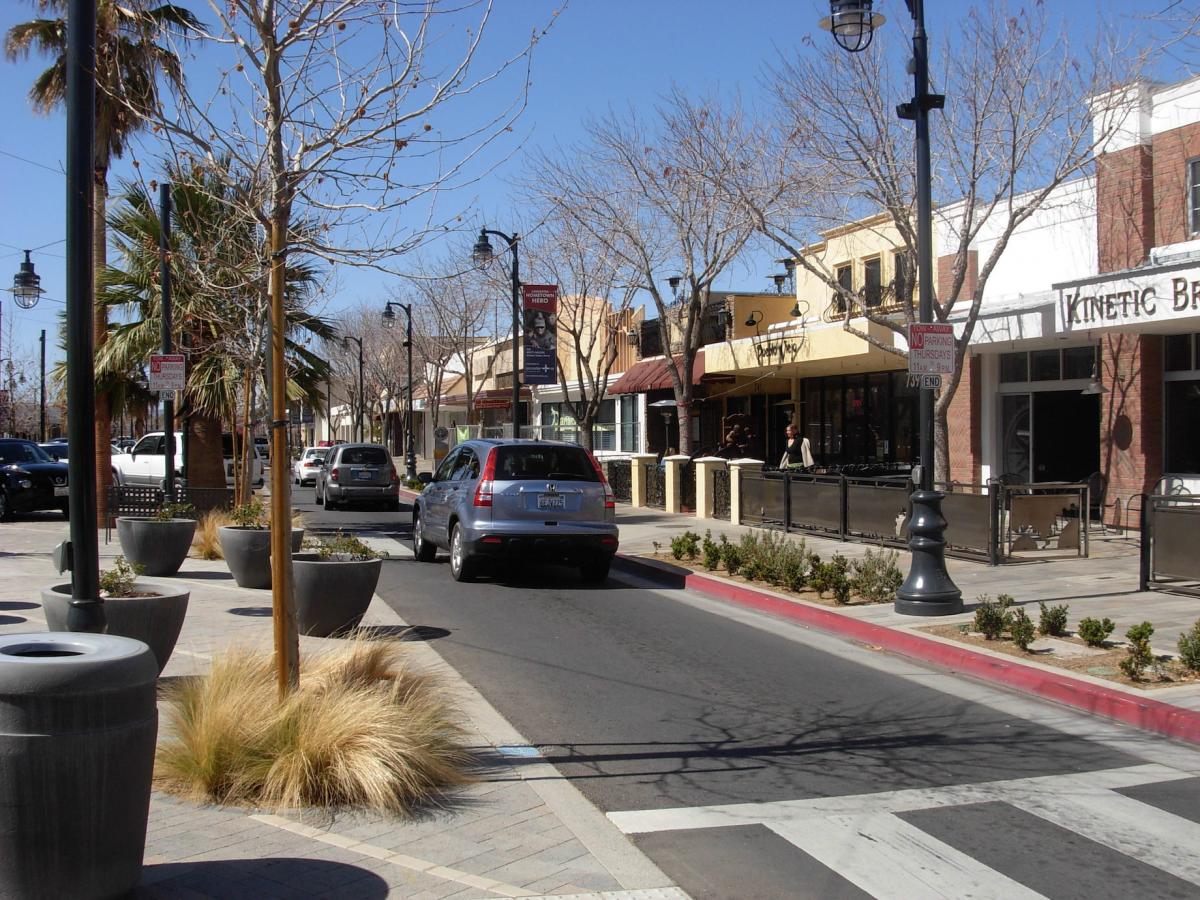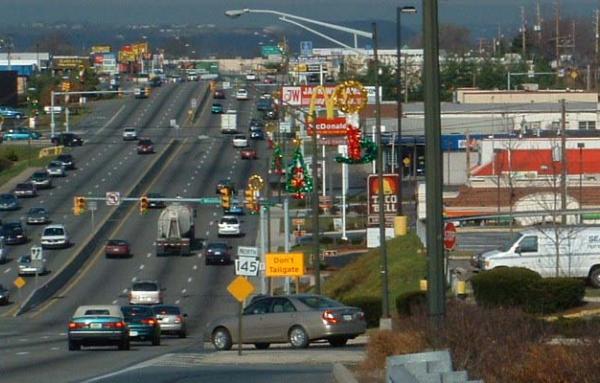
The new science of street design
In his excellent recent book Street Smart, veteran New York transportation engineer Sam Schwartz recalls a 1980s battle over the Williamsburg Bridge. Schwartz was the city’s transportation commissioner when he received the bad news: The 1903 bridge, which carried a quarter-million New Yorkers daily, was in danger of collapse.
Schwartz faced a choice that required federal funding: Replace the span or repair it. Replacement did not strike Schwartz as the right thing to do. "Had we decided to replace the bridge, New York would have had to spend [an extra] three-quarters of a billion dollars on a bridge whose primary effects would have been to destroy existing neighborhoods on both sides of the East River and put even more cars and trucks on Manhattan streets."
The feds wanted to do just that. The bridge did not fit the prevailing theories on safe streets. The Williamsburg Bridge’s lanes were narrow—less than 9 feet at the towers. To convince the federal government that replacement would be the wrong course, Schwartz mapped traffic collisions on the bridge for a three-year period. It turned out the safest part of the bridge was the narrowest part—even though its lanes there were far short of the standard, recommended 12-foot lane widths. Schwartz’s hypothesis, since confirmed by many studies, is that drivers are more careful when lanes are narrow.
Although the bridge was saved along with (what is now) billions of dollars’ worth of homes and businesses, the findings raised no curiosity among transportation and traffic engineers. No one suggested further studies. The incident was quickly forgotten, except by Schwartz. At least since the 1960s, engineers had designed urban thoroughfares on the theory that wide streets, lacking in nearby obstacles like trees, parked cars, and lampposts, are the safest. To the detriment of people and communities, these designs suppressed other uses of urban streets—such as walking, biking, socializing, and transit—but that outcome was either ignored or deemed an acceptable trade-off.
In a 2005 article called “Safe Streets, Livable Streets,” in the Journal of the American Planning Association, Eric Dumbaugh reported how this design theory came out of conjecture, not science. The definitive research in support of this theory was not a scientific analysis at all, but rather a description of crashes in a particular city, writes the Florida Atlantic University associate professor. When data from academic studies and real-world experience like Schwartz’s contradicted the theory, the data was explained away as aberration.
Dumbaugh cited, at the time, at least 10 studies that contradicted the wisdom of the transportation engineering profession on this subject, and he conducted his own study designed to test the theory of what he calls “forgiving design.” Without a doubt, this concept leads to more injury and death in populated areas. All of the data pointed to a better theory: In urban places, obstacles and constrictions make streets safer, because they cause motor vehicle operators to drive more carefully.
The most extreme examples are chicanes, which place an obstacle directly in front of the driver. According to conventional theory, these should be disastrous. But chicanes and road narrowings had been shown to reduce collisions by 74 to 82 percent (Zein 1997).
Dumbaugh’s article received less attention than it should have—at least in the US—perhaps because transportation engineers were not ready to fully absorb the message. If so, they should be ready now. Not only has the profession made some progress toward reform, but also more extensive studies have since removed all doubt about the new theory and the inadequacy of the old one. (See my recent article).
As Dumbaugh related, manuals and accepted best practice up to 2005 continued to instruct traffic engineers to remove obstacles and design for the highest practical speed by employing wide roads. While the practice is changing, signs of a major shift in engineers’ ways of doing things are still hard to find on the ground. Streets and intersections in urbanized areas continue to be overbuilt. A definitive study shows the long-term effects of this approach: more than three times the fatalities, three times less walking, four times less transit use, six times less bicycling in a dozen California cities (Garrick and Marshall 2008).

Current reform efforts
Two ideas—context-sensitive solutions (CSS) and Complete Streets—have recently improved street design, but problems persist. Neither of these approaches directly addresses the underlying theory’s defects. CSS is designed to solicit better input from the public and take urban context into consideration; Complete Streets emphasizes that thoroughfares should be designed for all users.
Complete Streets is treated as an alternative approach, and in the hands of skilled designers, this approach has generated excellent stretches of thoroughfare.

Too often, however, it means adding features—such as crosswalks or bike lanes—to over-wide streets that are still dominated by motor vehicles.

To be clear, Complete Streets is an important trend. But the transportation engineering profession must go further, and face the underlying issue: The old theory of forgiving design is not scientifically valid. If traffic engineering is based on science, the profession must embrace the new theory that explains the facts and deals with the complexity of urban streets.
This puts a whole new spin on street design for urban neighborhoods and downtowns; villages in rural areas; towns; and streetcar suburbs. These aren’t merely “non-conforming places,” to be respected or not. They are now the model. They are to be studied and emulated, much as new urbanists have done, because these thoroughfares are living, functioning examples of how vehicular lanes and intersections can be constricted effectively. Currently, too few engineers study these models.
Engineers should be thinking about maximum street widths and making the streets narrower, rather than about minimum widths and expanding them. Engineers can test the limits on constraining dimensions, using the best old streets and neighborhoods as guides. The capacity of urban thoroughfares can vary as needed.

This new way of thinking doesn’t apply just to cities; it suits walkable places in suburbs and small towns, as well. And it doesn’t apply just to old neighborhoods; it can be employed in new neighborhoods intended for walkability and in automobile-oriented communities that people want to transform.
This new theory needn’t be used in absolutely every setting. Wide-open thoroughfares are appropriate as freeways and as highways between cities and towns. In places where nobody wants walkability, there is less reason to reverse the old approach. Yet more and more communities do want streets to serve multiple purposes. And in these places, using a theory that explains reality is paramount. What’s needed in these places is the radically different approach I’ve presented here—an approach that can be applied whenever streets are to be resurfaced, rebuilt, or built from scratch.
Urbanized communities don’t need Complete Streets only as an option—they need it as a standard method. Transportation professionals should understand, as well, that if Complete Streets are built with dimensions that are too large—encouraging drivers to speed—they’re wasteful and ineffective.
The side-effects of using the wrong theory are extremely damaging. Streets play a crucial social and economic role in cities and towns. Well-connected street networks are associated with higher land values and, therefore, more tax revenues. Educated millennials are attracted to walkable places: Municipalities looking to attract this generation will be hurt if the old traffic-engineering paradigm remains in force.
Regrettably, in most jurisdictions, the dimensions of the older and narrower streets were made illegal during the past half-century. An increase in suburban street widths can be traced to 1965, when the Institute of Transportation Engineers hiked its minimum from 26 feet to 32 feet—which harmed walkability.
The streets that were rendered illegal actually fit the new theory of what makes a street safe and functional. In many communities, the laws and standards promulgated by the ITE and other organizations in the middle of the last century remain in effect. Any of the street standards based on the old, erroneous thinking should be looked at skeptically.
The new theory requires comprehension, and it requires new training. Traffic engineers must have a solid grasp of the multiple functions of streets and of their social and economic importance to cities and towns. Engineers need to understand—and be able to explain—the trade-offs and side-effects of various approaches. As I explained in a previous article, one excuse for wider travel lanes is the danger to bus and truck mirrors. Those who still believe in the theory of “forgiving design” may be in favor of widening the streets, to reduce the number of broken mirrors. In the new way of thinking, however, a minor threat to a replaceable part (mirrors) hardly justifies increased risk to humans and the damaging side-effects to communities. Mirrors can be designed to collapse and not break even if they are clipped.
I must point out—as I did in a previous article—that engineers aren’t uniquely to blame. Local land-use regulations also exert a substantial impact on street networks and sprawl. Still, traffic engineering sets the framework for what kind of community is possible.
In response to my recent article, a licensed professional in the Boston area commented: "I'm a traffic engineer too, and I can at least say that the dogma has changed in the past decade, and there aren't a whole lot of wider-is-better thinkers left."
That’s good to hear, but three problems remain:
1) Widespread doubts about the old theory are one thing—but widespread understanding of the new theory is just as important, and the evidence of that is lacking.
2) The profession has not made a concerted effort to use every opportunity to correct past mistakes.
3) The profession has not fully explored the implications of the new theory. More studies are needed, for example, on topics such as intersections.
Dangerous intersections
If roads have gotten wider, intersections have become huge. Two dimensions affect the size of intersections—street width and curb return radii. Since modern street design often increases curb radii even more than it increases street width, junctions in the suburbs often are two, three, or four times the size of typical urban intersections.

This creates wide-open conditions that we now know are more dangerous—at precisely the points where crashes are most likely to occur. Pedestrians, furthermore, are more numerous and exposed to traffic at the points where streets cross. It is not uncommon for intersections to require a 100-foot plus crossing. Most pedestrians will avoid such a crossing at all costs.
As nearly as I can determine, no studies look at the impact of enormous intersections on safety or street life. But we can be sure that the impact is not good.
The story relayed by Schwartz at the top of this article hints at the waste, not only in lives and disabling injuries, but in real estate and tax economics, of the old way of thinking. Billions of dollars in extra costs and in destruction of existing value hinged on a single decision that was doggedly opposed by one non-conforming traffic engineer—Schwartz. The decision fortunately went the right way, but thousands of others turned out differently.
Engineers could begin by aggressively redesigning thoroughfares in strategically targeted places. Wherever local land-use regulations and plans call for walkable urban places, cost-effective changes can be made in street dimensions and design.
According to the new theory, large street trees close to the vehicle path are good, not bad. On-street parking, bicycle lanes, narrow travel lanes, small blocks, well-connected thoroughfare networks, and small intersections are excellent things to aim for. Very narrow yield streets are likewise good in low-volume areas. All of these are valuable tools with which to create safer streets.
In mixed-use neighborhoods and places where cities and towns desire walkability, the approach that’s needed is the opposite of conventional traffic engineering as practiced for much of the last half century.
Transportation engineers, who have been struggling with how best to reform, should view this as a great opportunity. A new theory, backed by careful studies, offers a clear way forward. Safe and effective mobility no longer need conflict with the multidimensional role of streets as public spaces and with people’s varied modes of travel. Engineers can become the leading experts in street types and networks that constrict and disperse vehicular traffic. In doing so, transportation engineers can become primary enablers of better communities.
See also:





